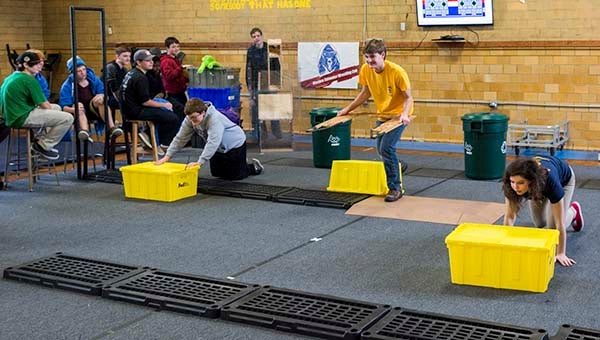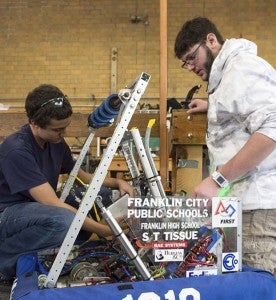Franklin Robotics season gearing up
Published 10:47 am Wednesday, January 7, 2015

From left, Elijah Steele, Chad Biever and Franklin’s Cindy Mitrovic act out what their robots would do in the autonomous portion of the game. — MURRAY THOMPSON | TIDEWATER NEWS
FRANKLIN
On Sunday, many local students got on their hands and knees to pretend to be… robots?
It was all part of the Franklin High School FIRST Robotics team’s strategy session, in which several area teams were invited to the Charles Street Gym to visualize the rules for the upcoming season, titled “Recycle Rush.” Teams were experimenting with the rules for the first time, as the FIRST Robotics program kicked off this past Saturday.

Franklin Student Donald Wintersteen, left, explains functions of last year’s robot to a member of a visiting team. — Murray Thompson | Tidewater News
“This game is different from previous years in that our alliance will have basically no direct interaction with the opposing alliance, and therefore there will be no defense,” said Kyle Johnson, a mentor for the FHS program. “This is a solely offensive game aimed at working with your teammates to score the maximum possible points.”
The object of “Recycle Rush” is to stack plastic shipping totes on top of scoring platforms. Teams gain significantly more points for placing recycling bins on top of the stacks.
On Sunday, teams from Chesapeake, Newport News, Portsmouth, Petersburg and, of course, Franklin got together to share ideas and act out the competition.
“Working together to benefit everyone is something that all the Hampton Roads teams have been working harder to do in the past few years,” Johnson said. “As a group we discussed the new game, new rules, calculated possible point values and weighed pros and cons of completing each of the game objectives.
“Bringing in new people benefited everyone by being able to share new ideas with the entire group. Playing the game as humans allowed everyone to see the flow and scoring potential of a real match.”
Cindy Mitrovic, the team’s captain, got a chance to pretend to be a robot in the name of science. She said she liked this year’s game.
“This year’s game is made with teamwork in mind and forces teams to cooperate in order to achieve success,” Mitrovic said.
While teams do not work together exactly as in the past, there is a coopetition (cooperation plus competition) aspect. Teams can get extra points by stacking yellow bins together on the bridges between the squads.
“The game incorporates concepts from previous FRC games to create the ultimate engineering challenge,” Mitrovic said, as there was a stacking game back in 2003. “We must consider and combine many possible solutions when designing and building the robot.”
Donald Wintersteen, a ninth-grader who will likely be in the pit again this year, said it was fun to meet with the other teams.
“It was interesting to talk to all of the teams and see what they had for ideas,” he said. “The coolest part about this year is that we are not facing off like last year. There’s no win loss or tie, it’s about scoring as many points as you can, and that decides it.”
Wintersteen said he thought the team aspect will be very important this year.
“To get everything done, we have to work together as a team,” he said. “If one part of the team falls out, it won’t work.”
Teamwork’s also important for the alliance.
“If you mess up, and knock down crates, it costs your team points, and the other team in the alliance,” Wintersteen said. “But, as long as you are doing the right thing, and doing it fast, you are guaranteed to get points. As long as you stack nice, it’s good.”
Elizabeth Conner, a programer for the team, was looking forward to some of the new aspects of the program.
“I’m most excited about working with the new control system,” she said. “All of the components have changed this year, including the processor that is 500 percent faster than what we’ve used before.”
Johnson said the first decision they have to make as a team is to review everything and decide how they want to play the game. After that, it’s figuring out how to design a robot that can most efficiently complete that strategy.
“Deciding our strategy quickly is imperative to the design process and prototyping,” he said. “We can then move on to building the actual robot, installing electronics, programming, testing, driver training and practice for competition.”
“I like the design aspect the most, and seeing how everything comes together,” Wintersteen added. “Right now, we are trying to figure out what we want our robot to do. We are trying to figure out what sort of arm we should use, and what kind of drive we should have.”
They’ll first figure out the best wheels to use, Wintersteen said, and work from there.
“We’ll try to see which ones work better, which ones are easier to program with, and then go from there,” he said. “Once we decide that, we’ll decide the frame, how to mount it, and then we’ll start prototyping. We’ll probably prototype this weekend.”
Build season runs until the deadline of Feb. 17, and Johnson said they’ll meet almost every day during that time to complete the robot.
The team will compete in the Virginia Regional on March 19-21 in Richmond at the Virginia Commonwealth University campus, and then at the Chesapeake Regional Tournament on April 2-4 at the University of Maryland at College Park, Maryland.
Contributing photographer Murray Thompson added to this report.





